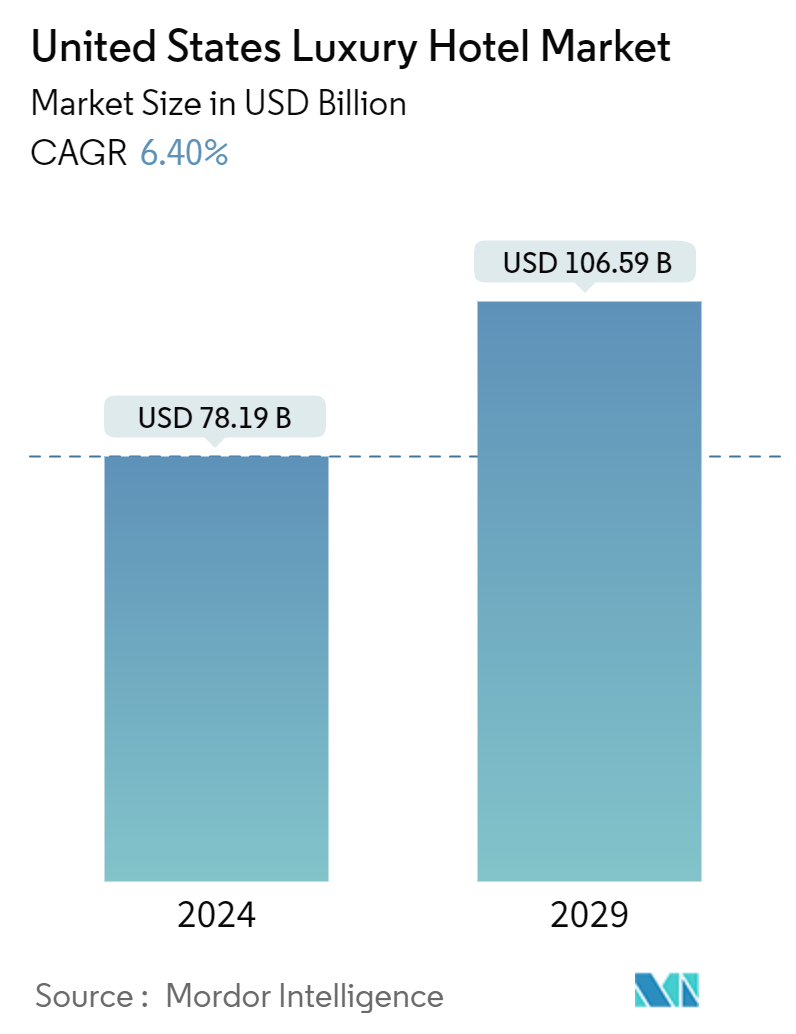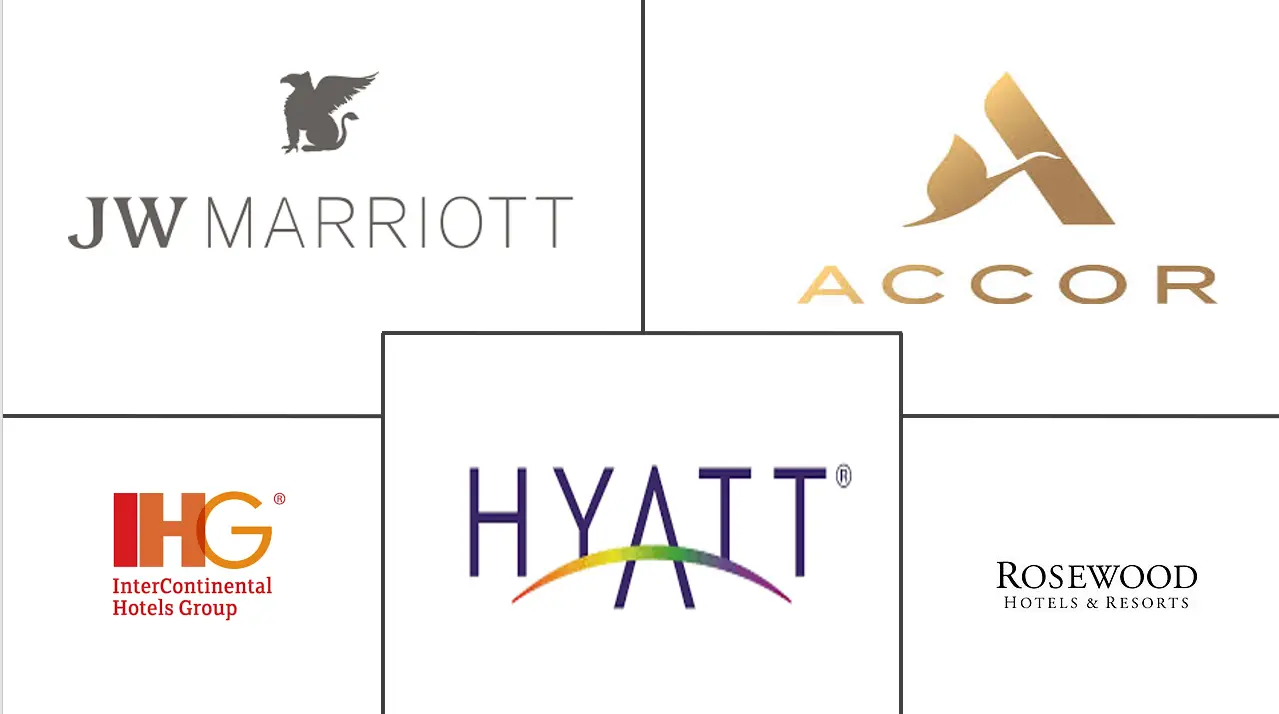Market Size of United States Luxury Hotel Industry

| Study Period | 2020 - 2029 |
| Base Year For Estimation | 2023 |
| Market Size (2024) | USD 78.19 Billion |
| Market Size (2029) | USD 106.59 Billion |
| CAGR (2024 - 2029) | 6.40 % |
| Market Concentration | Low |
Major Players
*Disclaimer: Major Players sorted in no particular order |
United States Luxury Hotel Market Analysis
The United States Luxury Hotel Market size is estimated at USD 78.19 billion in 2024, and is expected to reach USD 106.59 billion by 2029, growing at a CAGR of 6.40% during the forecast period (2024-2029).
The US luxury hotel market epitomizes opulence, sophistication, and top-tier hospitality, designed to cater to discerning travelers. These guests seek not just a stay but an experience that defines luxury. From iconic urban landmarks to serene resort getaways, US luxury hotels promise a diverse range of experiences, each crafted to surpass the expectations of even the most discerning patrons.
These hotels are renowned for their lavish amenities, meticulous attention to detail, and exquisite designs, creating sanctuaries of indulgence and relaxation. Be it Michelin-starred dining, world-class spas, or personalized concierge services, these establishments leave no stone unturned in ensuring an unforgettable guest experience.
Moreover, the US luxury hotel industry thrives on fierce competition and relentless innovation. Hoteliers consistently push boundaries, leveraging cutting-edge technology, championing sustainability, and forming exclusive partnerships with top brands. While the United States maintains its status as a luxury travel hub, the market adapts to embrace trends like wellness tourism and experiential travel, all while upholding its commitment to excellence and unparalleled hospitality.
United States Luxury Hotel Industry Segmentation
A luxury hotel provides a premium lodging experience, catering predominantly to affluent clientele with a focus on top-tier services and gourmet dining.
The US luxury hotel market is segmented by service type (business hotel, airport hotel, suite hotel, resort and spa, and other service types) and theme (heritage, contemporary, modern, and other themes). The report offers market sizes and forecasts in terms of value (USD) for all the above segments.
| By Service Type | |
| Business Hotels | |
| Airport Hotels | |
| Suite Hotel | |
| Resorts | |
| Other Service Types |
| By Theme | |
| Heritage | |
| Contemporary | |
| Modern | |
| Other Themes |
United States Luxury Hotel Market Size Summary
The United States luxury hotel market is experiencing robust growth, driven by an increase in both international and domestic tourism. The market is benefiting from a rise in international sporting events, trade shows, and exhibitions, which are attracting more visitors. This influx is further supported by evolving lifestyle standards and the expansion of the travel sector, which have collectively fueled the demand for luxury accommodations. The desire for upscale stays, whether for leisure or business, is propelling market expansion. Additionally, the advent of online booking services has streamlined the process, making it easier for travelers to secure luxurious accommodations. The availability of premium lodging packages and advanced technological amenities, such as intelligent bathrooms and complimentary WiFi, are also contributing to the market's growth by enhancing the guest experience and encouraging longer stays.
The growth of tourism in the United States is a significant driver of the luxury hotel market, as it leads to higher occupancy rates and increased spending on premium services. This surge in demand presents opportunities for luxury hotels to attract high-spending travelers, thereby boosting revenue. The market is also seeing an influx of Chinese tourists, which is further stimulating expansion. The competitive landscape is characterized by a mix of major players and smaller businesses, with top brands like JW Marriott, Rose Wood Hotel, and Ritz-Carlton maintaining a strong presence. Strategic partnerships, such as the one between Marriott and MGM Resorts, and mergers like those by Hyatt Corporation, are enhancing market offerings and expanding reach. These developments indicate a dynamic market poised for continued growth, supported by both domestic and international demand.
United States Luxury Hotel Market Size - Table of Contents
-
1. MARKET INSIGHTS AND DYNAMICS
-
1.1 Market Overview
-
1.2 Market Drivers
-
1.2.1 Increasing Number of Travelers Embracing Luxury Lifestyles
-
1.2.2 Building Brand Reputation and Fostering Loyalty
-
-
1.3 Market Restraints/ Challenges
-
1.3.1 Shifting Tastes Among Consumers
-
1.3.2 Increasing Operational Expenses
-
-
1.4 Market Opportunities
-
1.4.1 Focusing on Specialized Markets
-
1.4.2 Technological Progress
-
-
1.5 Porter's Five Forces Analysis
-
1.5.1 Threat of New Entrants
-
1.5.2 Bargaining Power of Buyers/ Consumers
-
1.5.3 Bargaining Power of Suppliers
-
1.5.4 Threat of Substitute Products
-
1.5.5 Intensity of Competitive Rivalry
-
-
1.6 Impact of COVID-19 on the Market
-
-
2. MARKET SEGMENTATION
-
2.1 By Service Type
-
2.1.1 Business Hotels
-
2.1.2 Airport Hotels
-
2.1.3 Suite Hotel
-
2.1.4 Resorts
-
2.1.5 Other Service Types
-
-
2.2 By Theme
-
2.2.1 Heritage
-
2.2.2 Contemporary
-
2.2.3 Modern
-
2.2.4 Other Themes
-
-
United States Luxury Hotel Market Size FAQs
How big is the United States Luxury Hotel Market?
The United States Luxury Hotel Market size is expected to reach USD 78.19 billion in 2024 and grow at a CAGR of 6.40% to reach USD 106.59 billion by 2029.
What is the current United States Luxury Hotel Market size?
In 2024, the United States Luxury Hotel Market size is expected to reach USD 78.19 billion.

